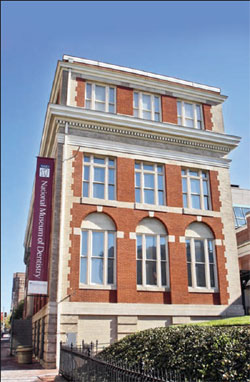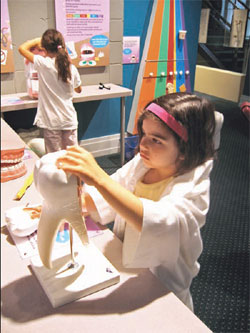The National Museum of Dentistry
Laura Sass
A “Must-See” Destination for Devotees of Dentistry
Within the walls of The Dr. Samuel D. Harris National Museum of Dentistry (NMD), visitors will find a reverence for the history of the profession, a nod to the exotica of the field, and a dedication to educating the public about the importance of good oral health.
“The museum uses its engaging exhibitions and programs to present dentistry in a positive, friendly manner. Designated by Congress as the official museum of the dental profession, NMD is a place for dentists to take pride in their profession,” says Rosemary Fetter, executive director of the Baltimore, MD, museum, which is an affiliate of the Smithsonian Institution.
Housed on the campus of the nation’s first dental school, NMD is heavily interactive, with a station designed for children to “play dentist,” complete with their very own dental chart and coat. As part of its MouthPower® exhibit, Mouthie®, the museum’s resident online dental expert, shows children how to correctly brush and floss, and there are models of teeth on which to practice both skills. Nearly every exhibit has something to touch: a button to push, a lever to pull, or a game to play.
“Children enjoy it because it is fun, educational, and interactive,” says Dr. Roger Levin, chairman of the board of visitors of the museum and CEO of Levin Group. “They get a chance to play dentist or assistant. At the same time, the museum is also for dentists. A dentist will never have more pride in his or her career than the day he or she visits the museum for the first time. I had that experience myself.”
A Brief History of Dental Time
The history of dentistry is a large part of NMD. An ancient human skull with pieces of jade in its teeth—thought to have been placed there for decoration—is displayed in a tower-like case. Arrays of dental instruments from the antiquated to the cutting edge adorn a tooth-shaped display. A large tube filled with murky liquid represents how much saliva the average human produces in a day. And, on the wall, benignly watching it all, sits a portrait of St. Apollonia, the patron saint of dentistry, with a serene look on her face and a single tooth grasped in what looks like pliers in her hand. There is a tower of dental chairs that climbs the entire length of the two-floor building, including a Victorian-era chair draped in velvet. A reconstruction of a post-Civil War traveling dentist’s operatory (at that time, dentists would double as silversmiths or blacksmiths, performing dentistry only part time, according to the exhibit) is only a few feet from a fully modern one, complete with computer imaging and other new technology. Instruments from every age of dentistry, including the dental kit used by Queen Victoria’s dentist, are displayed.
“You’ve got G.V. Black’s original office, who is the godfather of cavities. He was the first dentist to classify cavities, and they still teach the G.V. Black classification in dental school,” says Dr. Levin, whose two-year term as chairman ends this month.
Around the corner from the “godfather of cavities” is the father of the United States. George Washington has an entire room to himself, with one of the few remaining dentures that he used being the highlight of the display. It is only the lower half; the upper half was stolen before it came to the museum—probably for the gold—according to Amy Pelsinsky, director of communications of the museum. His dentures were made out of ivory, not wood as the legend goes, but wood was used for some of the dentures on display; some Japanese dentures used wood, according to the exhibit.
True Tooth Tales*
Using dental records to solve crimes and identify bodies may be commonplace now, but it is not a new practice. Teeth have been used for this purpose long before there were any trained dentists. The NMD highlighted a few cases:
CSI: Rome
Empress Agrippina (AD 15 – AD 59) thought that the former empress, Lollia Paulina, was a threat to her success and power. Even after Lollia Paulina was banished, Agrippina was not satisfied. So she ordered her soldiers to kill Lollia Paulina, and to bring back her head. By the time the soldiers tracked down and killed the unlucky Lollia Paulina and brought her back to Agrippina, the head had become so distorted that it was unrecognizable. Undaunted, Agrippina parted the lips and identified her victim by her “crooked smile.”
Revolutionary Identification
Dr. Joseph Warren was killed at the Battle of Bunker Hill on June 17, 1775. After the battle, the British troops stripped the bodies and hastily buried them in a mass grave. The doctor’s family had the body exhumed to give him a Christian burial. However, the family could not make a positive identification of Dr. Warren. The Boston physician and major general in the Massachusetts Militia was a patient of Paul Revere, a local silversmith and sometimes dentist. Revere, of “The British are coming!” fame, was called upon to help identify the body. As the skull contained a partial denture, Revere was able to recognize his own work and identify the body.
Recalling the Past, Eyeing the Future
NMD also houses many dental papers, including Robert Arthur’s 1841 Baltimore College of Dental Surgery diploma, the world’s first earned dental degree; Horace Hayden’s 1810 dental license, the first in the United States; and the minutes of the American Society of Dental Surgeons, the first national dental organization in the United States, among others.
“We have an amazing library and archive. It is just an incredible amount of information and education and history there. If we did not have it, we would have no repository for our history,” says Dr. Levin.
NMD is using the internet to spread awareness about the museum, and it is breaking records for hits on almost a monthly basis, according to Dr. Levin. “We are using technology to bring the museum to more and more people,” he says. “It has really opened up tremendous avenues for reaching people.
“Dentists love the museum,” he adds. “It is part of all of us. We are getting more and more organizations involved, more dentists involved, and it is just terrific to have a hand in the development.”
In addition to the NMD’s permanent collection, 32 Terrific Teeth, special, limited-engagement exhibitions include The Marvelous Mouth; Modern Dental Operatory; Saliva: A Remarkable Fluid; MouthPower®; Forensics: Solving Mysteries; and The Narwhal: A Whale of a Tooth. The NMD is located at 31 South Greene Street, on the campus of the University of Maryland. Hours of operation are: Wednesday to Saturday, 10 AM to 4 PM, and Sunday, 1 PM to 4 PM. Visit www.dentalmuseum.umaryland.edu or call 401-706-0600 for additional information.
*Source: The Dr. Samuel D. Harris National Museum of Dentistry.
 |  |
| The Dr. Samuel D. Harris National Museum of Dentistry in Baltimore, MD. Photo courtesy of Matthew Germain. | Children can disassemble a model of an oversized tooth at the MouthPower exhibit. |



